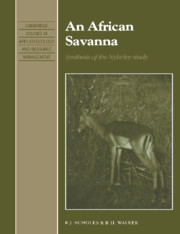Book contents
- Frontmatter
- Contents
- Preface
- I Nylsvley in an African savanna context
- II The key determinants: water, nutrients, fire and herbivory
- III The carbon cycle
- IV Community and landscape pattern and change
- 12 Rich savanna, poor savanna
- 13 Community structure, composition and dynamics
- 14 Tree–grass interactions
- 15 Plant–herbivore interactions
- Part V Lessons from Nylsvley
- Bibliography
- Index
12 - Rich savanna, poor savanna
Published online by Cambridge University Press: 06 October 2009
- Frontmatter
- Contents
- Preface
- I Nylsvley in an African savanna context
- II The key determinants: water, nutrients, fire and herbivory
- III The carbon cycle
- IV Community and landscape pattern and change
- 12 Rich savanna, poor savanna
- 13 Community structure, composition and dynamics
- 14 Tree–grass interactions
- 15 Plant–herbivore interactions
- Part V Lessons from Nylsvley
- Bibliography
- Index
Summary
Ecologists have traditionally subdivided the African savannas into functionally different types along a moisture gradient: wet savannas, mesic savannas and arid savannas, for example. The species composition, vegetation structure and key ecological processes in an arid savanna are clearly different from those in a wet savanna, but there is a gradual transition between these extremes. The distinct changes in composition, structure and function which are apparent in the field are usually related to soil changes; which can lead to water availability differences, or fertility differences, or both. On a continental scale, the moisture gradient and the soil fertility gradient are correlated to a large degree: areas of high rainfall have leached, infertile soils; while arid regions tend to have relatively fertile soils. For this reason, the first level of subdivision of African savannas proposed by Huntley (1982) is between the arid/eutrophic types on the one hand, and the moist/dystrophic types on the other. While this is a valid scheme in a general sense, it tends to obscure the fact that both arid dystrophic and moist eutrophic savannas do occur, although they may not be large in extent.
Scholes (1990b) argued that the changes caused by soil fertility are both more discrete and more fundamental than the changes caused by water availability. It is therefore more useful to distinguish between fertile and infertile, rather than between wet and dry, as a first level in the ecological classification of savannas.
- Type
- Chapter
- Information
- An African SavannaSynthesis of the Nylsvley Study, pp. 190 - 207Publisher: Cambridge University PressPrint publication year: 1993



